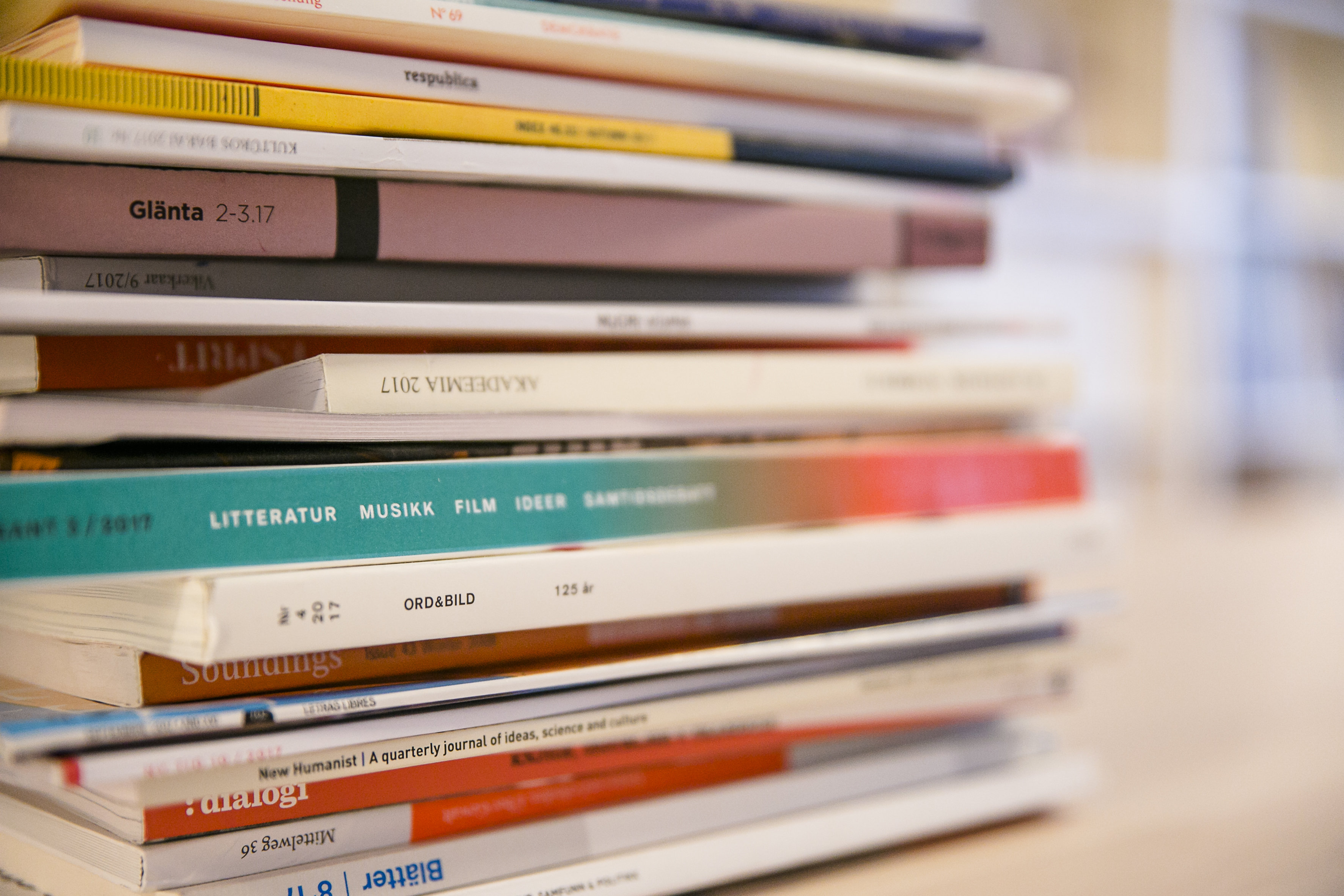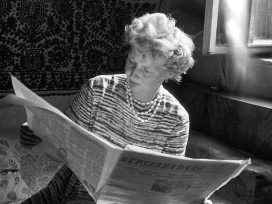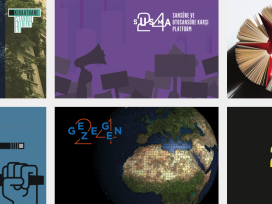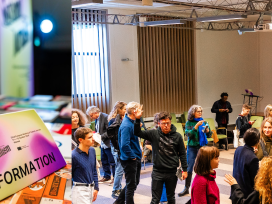December 2014 was a while ago now, but it is still clearly remembered in the small world of Swedish culture. This is a world where everyone knows everyone else, pretty much, and which is sometimes – not entirely unfairly – dismissed as a duck pond.
A duck pond is somewhere you can swim around in peace, dip your head under the water undisturbed and wag your tail in the air. There is always plenty of chatter, as well as the occasional power struggle between the alpha-ducks. It goes without saying that some ducks can’t abide certain other ducks. It’s the same in any pond.
But every now and then the pond goes into uproar, with the ducks uniting against some external enemy: an enemy that is also the hand that feeds them. For the pond is an ecosystem that is neither autonomous nor self-sufficient. Even though the ducks show great creativity in how they shape their environment, they ultimately depend on outside support.
What happened was this: in December 2014, the centre-right majority opposition (supported by the far-right Sweden Democrats) forced the newly elected Social Democratic minority government to adopt its much reduced budget. State funding for cultural journals was slashed from roughly 1.7 million euros per year to just 400,000 euros (75 per cent). A trivial sum in the national budget, but a disaster for journals, which suddenly faced an existential crisis. In 2014 there were about a hundred cultural journals in Sweden receiving state support, spanning literature and music to minority cultures. Many of them now faced insolvency.
The duck pond mobilised against the proposal, writing angry articles, signing petitions and holding protests outside parliament. Incredibly, the culture ducks were victorious: they created so much pressure that the centre-right opposition was forced to back down and adjust its budget. The proposal was amended and funding for cultural journals remained unchanged. A rare victory for independent culture in a land of engineers.
Readers may be wondering what kind of state support we’re talking about here, and why cultural journals, of all things, are receiving it. The Kulturrådet (Swedish Arts Council) calls it a ‘production subsidy for cultural journals’, describing the support as a grant programme ‘intended to promote diversity, quality, dissemination and reading of cultural journals’:
By ‘cultural journal’ we mean a journal that is published regularly several times a year and has content aimed at a general audience. The journal must contain cultural debate in a broad sense or provide space for analysis and showcasing of culture and the arts.
The funding is distributed every year and in 2022 amounted to around two million euros. Applications are assessed by an independent panel of journalists, authors, critics, researchers and librarians, which then passes them, with recommendations, to the Kulturrådet, which takes the final decisions.
Applications are evaluated in terms of gender equality as well as the journals’ financial needs and estimated revenues. Attention is paid not only to their content, but also to their technical and editorial quality, including design and images. The content is assessed from a number of angles, including innovativeness, originality, relevance, reliability, quality of analysis and appeal.
It is immediately clear that quality is key. This is sometimes criticised for being an opaque and subjective concept that is undemocratic in that it risks arbitrariness in deciding who receives funding, how much and why. There is already a hierarchical support structure in Sweden, critics point out, with the most prominent and established journals receiving far more than the smaller ones. There are therefore calls for support for freedom of expression in general, with no selection process and no opportunity for the state to suppress unpalatable or undesirable views.
Of course, criticisms of funding systems and criteria are always necessary. But they are, or should be, part of a healthy public debate. Reviewing a book about the ‘fight for the journals’, Swedish critic Ulf Eriksson strongly opposed general funding, arguing that ‘dismantling selective support risks removing the incentive to focus on quality. Selective support and a focus on quality probably go hand in hand. It can even be seen as the fundamental principle of journal editing: sifting out and editing, encouraging and criticising – taking writing seriously, in other words.’
Others take the view that the support should be varied more often, with journals receiving different amounts each year. This, however, treats journals like vending machines: put money in and get reviews out. But that is not how it works. Journals consist of working people making contacts, building networks, taking a position and ultimately ensuring continuity – something that should not be undervalued.

Copyright: Eurozine
Preserving diversity
In Sweden, state support for newspapers and journals was introduced in the 1960s, mainly due to a serious crisis in the advertising market, but also to prevent political interests – those of wealthy magnates and newspaper empires – from becoming too dominant. The aim both then and now was to protect diversity and freedom of expression under the umbrella of the social democratic welfare state.
Norway, Denmark and Finland have similar funding programmes for similar reasons. Support for cultural journals is somewhat higher in Norway and considerably lower in Denmark, despite a similar population size. In Norway, total funding is more than 2 million euros; in Denmark it totals only about 230,000 euros. For Danish literary journals such as Standard or Atlas, this amounts to just 4000–5000 euros per year
This kind of state support has long long taboo in Germany, for example, where it is feared that state subsidies for the press would hamper journalistic independence. In the words of Mathias Döpfner, former president of the Publishers’ Association and CEO of the Axel Springer Group: ‘Better for newspapers to go bust than for subsidies to destroy their independence.’ In Germany, aversion to the idea of a state subsidised press has its roots, at least in part, in history. However, it is shared in other countries, above all in the Anglo-Saxon space, where the liberal press tradition is strong.
Not even small cultural journals in Germany receive federal support (although the federal states sometimes provide grants for special projects or expenditure). Financially secure institutions such as the Literary Colloquium Berlin (Sprache im technischen Alter), the Academy of Arts (Sinn und Form) and the Hamburg Institute for Social Research (Mittelweg 36) ensure continuity for their in-house journals. But independent journals such as Positionen are at the mercy of the free market and highly dependent on volunteers and often underpaid editors and critics.
This does not mean, however, that state-subsided journals in Scandinavia live in glorious abundance or a land of cultural milk and honey.
I have been working as an unpaid editor for the Norwegian/pan-Scandinavian journal Vagant since 2015. That’s the way it is with almost every – not to say every – journal in Scandinavia. They may have one full-time employee or perhaps two part-timers. But most of the editorial staff work unpaid. Thanks to state funding, however, Vagant can at least pay contributors a reasonable rate in line with the guidelines laid down by the Norwegian Critics’ Association (another wonderful invention) – which is more than that paid by even the major German newspapers.
In Finland, which has a large number of Swedish-language journals in relation to the size of its Swedish-speaking minority, funding from the Finnish Arts Council is supplemented by an initiative to promote criticism in Swedish-language publications. The Critics’ Bureau pays its members a fee for each commissioned review, with the amount calculated on a sliding scale of between 80 and 30 per cent of the fee. Authors who have earned less receive more, and vice versa; if a journal pays a fee of 100 euros for a review, the Critics’ Bureau adds 80 euros. Not enough to live on, but for most authors a welcome bonus.
Despite all this, Scandinavian cultural journals are still fighting for their survival, especially in Denmark, which has the lowest subsidies. In 2016, for instance, Kritik was discontinued when the big publisher Gyldendal withdrew after 50 years of ownership. Denmark thereby lost its most important journal for literary criticism.
The closure of Kritik is indicative of a trend throughout Scandinavia. Ten or twenty years ago there were numerous journals whose existence was secured by publishers that could afford a few red figures in their balance sheets. In recent decades, however, publishing houses have been ditching their journals because they are unprofitable. In 2004 Albert Bonnier, Sweden’s biggest publisher, dropped its literary journal BLM (Bonniers litterära magasin). At the time, people thought this was a big mistake; but no other Swedish literary journal has stepped in to fill the gap. Literary criticism as a field has thus been significantly weakened. Today, not a single journal in Sweden is backed by a Swedish publisher.
In Norway, too, journals are currently undergoing a major upheaval. In 2016, Norway’s largest publisher Cappelen Damm parted from the journal Vagant because it was unprofitable. ‘Porn publisher ditches unsexy magazine,’ wrote the Norwegian newspaper Morgenbladet at the time. In 2020 it was announced that Gyldendal would no longer publish the major literary journal Vinduet in paper form, but only online. In 2022, Aschehoug parted ways with Samtiden. And so it goes on.
Towards the end of 2022, Audun Lindholm, editor-in-chief of Vagant since 2007, wrote a commentary in which he claimed that the publishing industry had abandoned its responsibility towards a critical public and was now just producing its own content in the form of ‘amazing author interviews’ or ‘fantastic book tips’ instead of serious reviews driven by editorial professionalism.
Supporting innovation
In neither Sweden or Norway is arts and cultural criticism am explicit prerequisite for press funding. This is handled by the respective arts councils in these countries, partly in the form of ‘production subsidies for journals’ or, as it is now called in Norway, a ‘support programme for journals and criticism’.
As Positionen editor Andreas Engström wrote in the May 2023 edition, ‘criticism is being increasingly sidelined in the daily press’. In the cultural journals, however, criticism is alive and well. But periodicals (literary journals especially) are also the most important showcase for other genres that have been dropped by the major newspapers: essays and short prose and poetry, for example.
Journals are driven by creativity, curiosity and future-oriented thinking. We often find that ideas and concepts first presented in Vagant eventually find their way into the major dailies. Journals are the spearheads, testing grounds and nurseries. This is where the feuilleton of tomorrow is born, often with very limited resources and largely dependent on the dedication of volunteers.
Subsidies have led to the professionalisation of cultural journals in Norway and Sweden. This is reflected in their design and paper quality, which is often extremely high. There are of course more basic versions: student magazines and fanzines, magazines that cultivate a punky underground aesthetic. Some of the Norwegian and Swedish journals have a long history: Norway’s Samtiden, for example, was first published in 1890; Sweden’s Ord & Bild followed two years later. They are simultaneously tradition bearers and pioneers. Many critics, heads of institutions, curators, authors and editors cut their teeth in cultural journals. It is where they learn their profession and can freely develop their skills. Cultural journals are essential if there is to be a vibrant, exciting cultural life.
The situation in Denmark is rather different. These days, the country no longer has any journals that could be regarded as traditional. Most Danish literary magazines are now produced in a student environment by young talent. These young publications do occasionally reach maturity: Standard, for example, which is devoted to reviews and literary criticism, was founded by students in 1987. Usually, though, they are short-lived, only surviving a decade or less.
A Nordic model for Europe
Since the Scandinavian languages are not widely spoken, state funding for cultural journals is essential if there is to be true diversity of opinion. Without them, there would be no independent thought in these languages and the critical public sphere would shrink to a fraction of what it is today, if not disappear altogether. Even the biggest and strongest journals would struggle to survive.
Journals in larger language spaces have it better, in a way, simply because the pool of readers is bigger. Most of the major Scandinavian periodicals have a circulation of 1000. According to Wikipedia, Germany’s Lettre International has a circulation of between 16,000 and 23,000 and more than 13,000 subscribers. No Scandinavian journal can hope to achieve such numbers.
But what about smaller or mid-sized cultural journals in the rest of Europe? How can they survive without a ‘Nordic model’, and what is the effect on a democratic public sphere when the diversity that in theory is to be defended, preserved and protected from political influences is restricted in practice?
For many years, cultural policy was based on the social democratic principle that the state should use subsidies to counteract the negative effects of commercialization in the cultural sector. This kind of argument has not been made for a long time. Nevertheless, the idea that the state should look out for smaller cultural practitioners, protect them and take them under its wing remains. This is essential, both for criticism and the creation of a new generation of critics. The critical public might not necessarily die out without the current range of Scandinavian cultural journals, but it would be significantly diminished. The duck pond would shrink and look even sadder than it does now. And would probably no longer be able to resist the impoverishment of cultural life.







